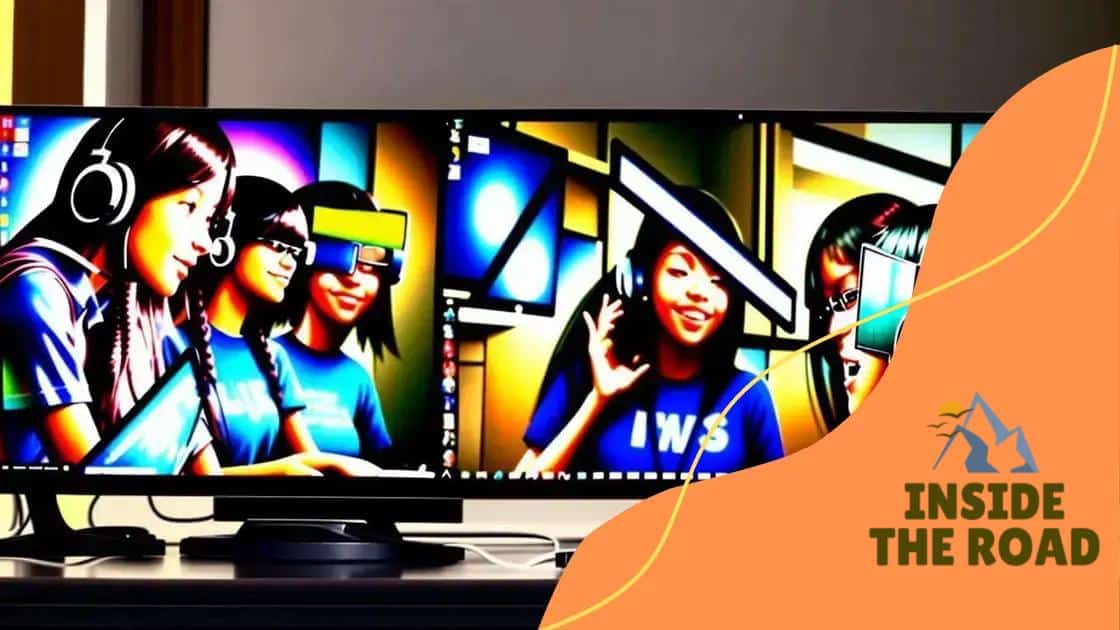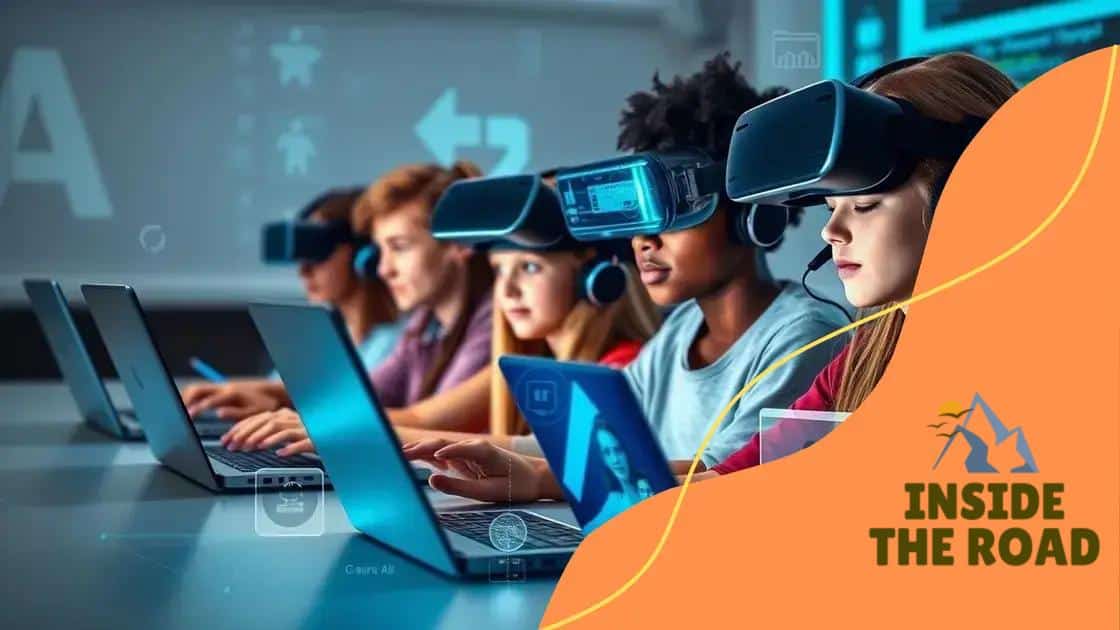How virtual classrooms are enhancing global education access

Virtual classrooms enhance global education access by providing flexible, technology-driven learning environments that overcome geographical barriers, promote collaboration, and support diverse learning needs.
How virtual classrooms are enhancing global education access has become a crucial topic in today’s learning landscape. With advancements in technology, education is no longer limited by geography. Are you curious about how these changes are reshaping our access to knowledge?
Understanding virtual classrooms
Understanding virtual classrooms is essential as they reshape education around the globe. These interactive online spaces connect students and teachers in real-time, fostering a collaborative learning environment.
Virtual classrooms offer numerous advantages. They provide flexibility in scheduling and location, enabling learners from diverse backgrounds to access quality education.
Key Features of Virtual Classrooms
Some of the standout features that make these classrooms effective include:
- Live Interaction: Students can ask questions and engage with instructors in real-time, simulating a traditional classroom experience.
- Multimedia Learning: Instructors can share videos, presentations, and interactive content, enhancing the overall learning experience.
- Asynchronous Access: Recorded sessions allow students to review content at their own pace, making it easier to grasp complex topics.
While technology plays a crucial role, the human element remains vital. Instructors can foster relationships with students, enhancing engagement through personalized communication. This combination of tech and personal touch creates a dynamic and responsive educational experience.
As we delve deeper into the realm of virtual classrooms, it’s clear that they are more than just a trend. They represent a shift towards more inclusive and accessible education. Individuals who previously faced barriers can now confidently pursue learning opportunities.
It’s important to highlight the challenges that come with this transition. Some students may struggle with technology or lack access to adequate internet services. Addressing these barriers is essential for maximizing the potential of virtual classrooms.
Key benefits of virtual education
The key benefits of virtual education have transformed how people learn. With online platforms, students can access resources from anywhere at any time, breaking traditional barriers. This flexibility allows learning to fit into busy schedules.
Accessibility and Inclusivity
One of the most remarkable advantages is that virtual education increases accessibility. Learners from all backgrounds can join classes without geographical limitations. This inclusivity promotes greater diversity.
- Global Reach: Students can connect with instructors and peers worldwide, enriching their learning experience.
- Variety of Resources: Virtual education offers diverse materials, including videos, articles, and interactive activities to suit different learning styles.
- Customized Learning: Learners can progress at their own pace, ensuring a deep understanding of the material.
Another benefit is the cost-effectiveness. Traditional education often comes with hefty tuition fees, but online courses tend to be more affordable. Students save money on transportation, housing, and other expenses.
Furthermore, virtual education fosters self-discipline. Learners are responsible for managing their time and commitments. This independence builds skills crucial for future success.
Enhanced Engagement
The use of technology in virtual classrooms boosts engagement. Interactive tools like polls, quizzes, and breakout rooms encourage participation. Students feel more involved and motivated to learn.
Moreover, virtual education promotes collaboration. Students can work together on projects, fostering critical thinking and teamwork skills. They learn to communicate effectively in digital environments, which is essential in today’s job market.
Technology shaping online learning

Technology is profoundly shaping online learning in innovative ways. With the rise of digital tools, students can access a variety of resources that enhance their learning experience. These advancements help create engaging and interactive environments.
Online Platforms and Tools
Many online platforms have become essential for virtual education. They facilitate communication between students and teachers, making learning more cohesive. Popular tools include:
- Learning Management Systems (LMS): These systems organize course materials, track progress, and host assessments.
- Video Conferencing Tools: Platforms like Zoom and Microsoft Teams allow for real-time interaction, replicating classroom discussions.
- Collaborative Tools: Tools like Google Docs enable group projects and peer review, making teamwork possible across distances.
Interactive technology also enhances engagement. For instance, gamification incorporates game-like elements into learning, motivating students to participate actively. This can transform tedious subjects into exciting challenges!
Artificial Intelligence in Education
Artificial intelligence (AI) plays a transformative role in personalizing education. By analyzing student performance, AI can suggest tailored content that meets each learner’s needs. This level of customization supports different learning styles and paces.
Moreover, AI-driven chatbots provide support outside traditional hours. Students can ask questions and receive instant answers, encouraging continuous learning. Such technology contributes to a more accessible educational experience.
The incorporation of virtual reality (VR) and augmented reality (AR) is also noteworthy. These technologies create immersive learning experiences that can make complex topics easier to understand. Imagine exploring the solar system or walking through ancient cities without leaving your home!
Challenges in virtual classrooms
While virtual classrooms offer many advantages, they also come with their own set of challenges. Understanding these obstacles is vital for creating effective online learning environments.
Technical Issues
One of the most common challenges is related to technology. Poor internet connectivity can disrupt classes, making it hard for students to participate. This can lead to frustration and lessen the learning experience. Additionally, not all students have access to reliable devices, which can affect their ability to engage fully.
- Device Accessibility: Some students may lack laptops, tablets, or stable internet connections, limiting their participation.
- Tech Savviness: Many students face difficulties if they are not familiar with the tools used in virtual classrooms.
- Platform Reliability: Occasionally, online platforms can experience outages or technical difficulties, disrupting lessons.
Another challenge to consider is the lack of personal interaction. In traditional classrooms, face-to-face communication fosters connections between students and teachers. Virtual settings can feel isolating for some learners, which may hinder their motivation and engagement.
Student Engagement
Maintaining student engagement in virtual classrooms is also tricky. With numerous distractions at home, students may find it hard to focus on the lessons. The absence of physical presence often means that students might not feel accountable, leading to decreased participation.
Additionally, teachers may struggle to assess students’ understanding effectively. In a traditional setting, they can rely on body language and immediate feedback. However, in a virtual environment, it can be harder to gauge whether students are truly understanding the material.
It’s also important to address the issue of learning differences. Not all students learn in the same way, and virtual classrooms may not cater to individual needs effectively. Teachers must find ways to accommodate various learning styles to ensure that all students receive a quality education. This remains a significant challenge for many educators.
Future of global education
The future of global education is rapidly evolving, driven by technology and changing learner needs. As more students access virtual classrooms, educational boundaries continue to disappear. This transformation promises a more equitable learning landscape.
Emerging Educational Technologies
Technological advancements will play a crucial role in shaping education. Tools like artificial intelligence, virtual reality, and blockchain can redefine the way we learn. For instance, AI can personalize learning experiences, tailoring content to the needs of each student.
- AI and Learning Analytics: AI can analyze student performance, helping educators identify gaps and provide targeted support.
- Virtual Reality Experiences: VR can transport students on virtual field trips, enhancing understanding of complex subjects.
- Blockchain for Credentials: Blockchain technology can help secure and verify academic records, making it easier for students to share their qualifications.
Another significant shift is the increase in collaboration among educational institutions. Schools and universities worldwide will partner to share resources, curriculum, and expertise. This collaboration can lead to more diverse learning options and better funding opportunities.
Focus on Lifelong Learning
The concept of lifelong learning will become essential as job markets evolve. Education will no longer be confined to youth; adults will continuously seek to upgrade their skills. Online platforms will play a key role in offering courses that cater to these lifelong learners. This evolution will create a culture where learning is valued and encouraged at all stages of life.
Moreover, we will likely see a stronger emphasis on soft skills necessary for future jobs, such as critical thinking, communication, and teamwork. Educational programs will integrate these skills into their curricula, preparing students for an unpredictable job market.
As the future unfolds, the vision is clear: a more inclusive education system where everyone has access to quality learning resources and experiences, regardless of their geographical location.
The future of global education holds great promise as technology continues to innovate and reshape how we learn. Virtual classrooms enhance accessibility, making education available to more people around the world. However, challenges remain, such as ensuring reliable technology and maintaining engagement. By focusing on collaboration and lifelong learning, we can create a more inclusive and adaptable educational system. As we move forward, it is essential to embrace these changes and prioritize the needs of every learner.
FAQ – Frequently Asked Questions about Global Education
What are the main benefits of virtual education?
Virtual education offers increased accessibility, flexibility, and personalized learning experiences for students around the world.
How does technology impact online learning?
Technology enhances online learning by providing interactive tools, facilitating real-time communication, and enabling personalized education through AI.
What challenges do virtual classrooms face?
Virtual classrooms can face challenges such as technical issues, lack of personal interaction, and maintaining student engagement.
How can collaboration improve global education?
Collaboration among educational institutions allows for sharing resources, expertise, and diverse learning options, enhancing the overall quality of education.






